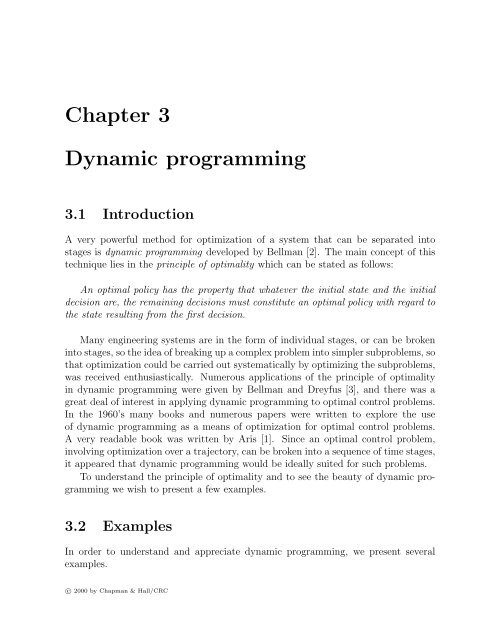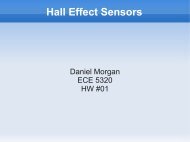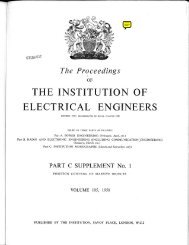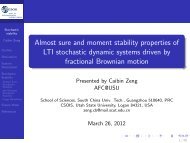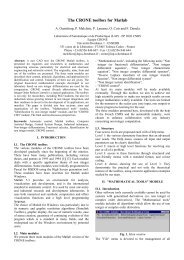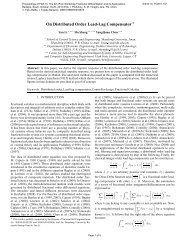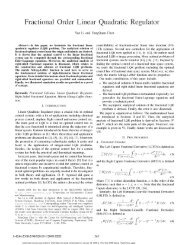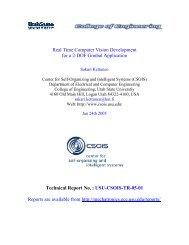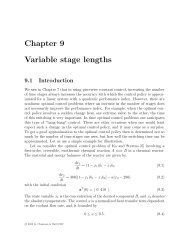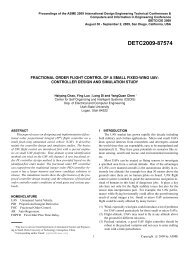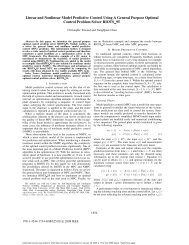Chapter 3: Dynamic programming - mechatronics
Chapter 3: Dynamic programming - mechatronics
Chapter 3: Dynamic programming - mechatronics
You also want an ePaper? Increase the reach of your titles
YUMPU automatically turns print PDFs into web optimized ePapers that Google loves.
<strong>Chapter</strong> 3<br />
<strong>Dynamic</strong> <strong>programming</strong><br />
3.1 Introduction<br />
A very powerful method for optimization of a system that can be separated into<br />
stages is dynamic <strong>programming</strong> developed by Bellman [2]. The main concept of this<br />
technique lies in the principle of optimality which can be stated as follows:<br />
An optimal policy has the property that whatever the initial state and the initial<br />
decision are, the remaining decisions must constitute an optimal policy with regard to<br />
the state resulting from the first decision.<br />
Many engineering systems are in the form of individual stages, or can be broken<br />
into stages, so the idea of breaking up a complex problem into simpler subproblems, so<br />
that optimization could be carried out systematically by optimizing the subproblems,<br />
was received enthusiastically. Numerous applications of the principle of optimality<br />
in dynamic <strong>programming</strong> were given by Bellman and Dreyfus [3], and there was a<br />
great deal of interest in applying dynamic <strong>programming</strong> to optimal control problems.<br />
In the 1960’s many books and numerous papers were written to explore the use<br />
of dynamic <strong>programming</strong> as a means of optimization for optimal control problems.<br />
A very readable book was written by Aris [1]. Since an optimal control problem,<br />
involving optimization over a trajectory, can be broken into a sequence of time stages,<br />
it appeared that dynamic <strong>programming</strong> would be ideally suited for such problems.<br />
To understand the principle of optimality and to see the beauty of dynamic <strong>programming</strong><br />
we wish topresent a few examples.<br />
3.2 Examples<br />
In order to understand and appreciate dynamic <strong>programming</strong>, we present several<br />
examples.<br />
c○ 2000 by Chapman & Hall/CRC
3.2.1 A simple optimal path problem<br />
Let us consider asituation depicted in Figure 3.1, where there are different paths that<br />
could be taken in going from A to B. The costs for sections of the paths are shown<br />
by the numbers. Suppose we wish tofind the path, always moving tothe right, such<br />
that the total cost in going from A to B is minimized. For ease of discussion, the<br />
nodes are labelled by the letters a, b, ···,l.<br />
Figure 3.1: Optimal path problem<br />
Starting at node a, we find that there is only one way togotoB and the associated<br />
cost is 5, so we associate the minimum cost 5 with node a. Similarly, there is only<br />
one way to proceed from node b and the cost is 3 plus the cost from going from node<br />
a to B. Thus we associate the minimum cost 8 with the node b. Proceeding to node<br />
c, since we are always going from left to right, we see that there is only one way to<br />
get to B and the associated cost is 7. At the node d, there are two options: one is<br />
toproceed tonode c and the other is toproceed tonode a. It is noted that here it<br />
does not make any difference, since the cost with each alternative is 11. Therefore we<br />
assign the minimum cost 11 to node d.<br />
At node e there are alsotwoways of proceeding. We can gotoeither node d orto<br />
node b. In the former, the cost is 5 + 11 = 16, and for the latter the cost is 5 + 8 =13.<br />
We compare these two numbers and choose the path that gives the smaller number,<br />
namely the path e to b, and associate with node e the minimum cost 13. Similarly<br />
at node f we compare the two costs 9 + 13 = 22 and 4 + 8 = 12, and associate the<br />
minimum cost 12 with the node f and the path f to b rather than f to e. At no de<br />
g there is only one way of proceeding, so the minimum cost associated with node g<br />
c○ 2000 by Chapman & Hall/CRC
is 8 + 7 = 15. At node h we compare the two costs 1+15=16and3+11=14,<br />
and choose the path h to d. Atnodei comparison of two costs gives us the minimum<br />
cost of 17 along the path i to h. Atnodej the minimum cost 14 is achieved by going<br />
from j to f. At the node k we compare the two costs 4+15=19and9+14=23,<br />
and choose the path k to g. At the node l we compare the two costs 5+19=24and<br />
2 + 17 = 19 and choose the path l to i which gives the minimum cost of 19.<br />
Now we proceed tothe starting point A. Here we have twoways of proceeding.<br />
For the path A to l the cost is 3 + 19 = 22, and for the path A to j the cost is 9 +<br />
14 = 23. Therefore we conclude that the minimum cost in going from A to B is 22<br />
and that there are twopaths that yield this cost: AlihdcB and AlihdaB.<br />
We note here that instead of doing the minimization as a whole problem, we solve<br />
a sequence of very simple minimization problems which involve comparing two numbers<br />
at the nodes. Some of the nodes were actually “free” where no optimization was<br />
necessary. Also it is observed that it is not possible to miss the global minimum, and<br />
if there is more than one path that yields the minimum, the method captures all of<br />
them, as was illustrated here. The computational advantage of this approach over<br />
exhaustive enumeration becomes more apparent as the size of the problem increases.<br />
For example, if instead of the 3 × 3 grid, we would have a 10 × 10 grid, the approach<br />
with dynamic <strong>programming</strong> could still be easily done by hand, but exhaustive<br />
enumeration of all the possible paths would be unrealistic.<br />
We now turn to a very similar type of a problem involving the scheduling of jobs<br />
that are to be done on a single facility in such a way that the cost would be minimized<br />
[4].<br />
3.2.2 Job allocation problem<br />
Let us consider a set of P jobs, called J1,J2, ···,JP tobe executed on a single facility.<br />
Associated with each job Jn is a time of execution τn and a cost function cn(t) giving<br />
the cost associated with completing the job at time t. For simplicity, we assume that<br />
only one job is executed at a time, that there is no interruption in a job once it is<br />
started, and the facility is constantly in use. The problem is to choose the ordering of<br />
the jobs such that the total cost is minimized. The performance index is thus chosen<br />
tobe<br />
P<br />
I = ck(tk), (3.1)<br />
k=1<br />
and we wish todetermine the order in which the jobs are tobe executed sothat the<br />
performance index is minimized. For all possible orderings we need to examine P !<br />
schedules, which becomes unmanageable when P is large. For this type of problem<br />
dynamic <strong>programming</strong> is well suited. We illustrate this with the case where P =5<br />
jobs. This problem is very similar to the optimal path problem discussed earlier. We<br />
picture the problem as involving 5 stages. At stage 1 we have 5 jobs and at stage<br />
5 we have a single job to consider. We start at the last stage (stage 5) involving a<br />
c○ 2000 by Chapman & Hall/CRC
single job. There is no optimization possible at this stage. The cost of doing job i<br />
incurs a cost ci(τi).<br />
Now let us consider stage 4 where two jobs are to be considered. There are 10<br />
possible sets of two jobs to consider. Each set has two permutations. For example,<br />
if we consider jobs J1 and J2, we ask whether the arrangement should be J1 followed<br />
by J2 denoted by J1J2, or whether it should be J2J1. For the order J1J2 the cost is<br />
c1(τ1) +c2(τ2 + τ1) and for the order J2J1 the cost is c2(τ2) +c1(τ1 + τ2). These costs<br />
are different since the cost of a particular job is dependent on the time when that job<br />
is finished. The two numbers are compared, and suppose that it is found that the<br />
latter arrangement gives a smaller cost. Then we know that in doing jobs J1 and J2,<br />
job J2 should be done first followed by J1. We carry out this comparison with the<br />
other 9 sets and then construct a table showing the arrangement of two jobs to yield<br />
the minimum cost, as is shown in Table 3.1.<br />
Table 3.1: Order and minimum cost for 2 jobs<br />
Ordered Jobs Minimum cost<br />
J2J1 c2(τ2)+c1(τ2 + τ1)<br />
J3J1 c3(τ3)+c1(τ3 + τ1)<br />
J1J4 c1(τ1)+c4(τ4 + τ1)<br />
J1J5 c1(τ1)+c5(τ5 + τ1)<br />
J2J3 c2(τ2)+c3(τ2 + τ3)<br />
J4J2 c4(τ4)+c2(τ4 + τ2)<br />
J2J5 c2(τ2)+c5(τ2 + τ5)<br />
J4J3 c4(τ4)+c3(τ4 + τ3)<br />
J3J5 c3(τ3)+c5(τ3 + τ5)<br />
c5(τ5)+c4(τ5 + τ4)<br />
J5J4<br />
Now we proceed to stage 3 where three jobs are to be considered. There are 10<br />
possible sets of 3 jobs taken from 5 jobs. Let us choose the set consisting of jobs J1,<br />
J2 and J3. Weuse the information in Table 3.1 to reduce the number of calculations<br />
required todetermine the order. If J1 is last, then we know the order in which jobs<br />
J2 and J3 are to be done and the cost associated with these two jobs from the fifth<br />
line of Table 3.1. All that is necessary is to add the additional cost c1(τ2 + τ3 + τ1).<br />
Similarly, if J2 is done last, the cost is the corresponding entry for jobs 1 and 3 from<br />
the second line of Table 3.1 plus c2(τ1 + τ3 + τ2); and if J3 is done last, the cost is the<br />
correspondingentryforjobs1and2fromthefirstlineofTable3.1plusc3(τ1+τ2+τ3).<br />
These three costs are compared, and the arrangement that gives the minimum cost<br />
is kept. Let us suppose that of these 3 arrangements, the order J2J1J3 gives the least<br />
cost. This entry appears on the first line of Table 3.2. This procedure is repeated<br />
c○ 2000 by Chapman & Hall/CRC
for the other 9 sets and the table is completed, showing the minimum costs for three<br />
jobs.<br />
Table 3.2: Order and minimum cost for 3 jobs<br />
Ordered Jobs Minimum cost<br />
J2J1J3 c2(τ2)+c1(τ2 + τ1)+c3(τ1 + τ2 + τ3)<br />
J3J1J4 c3(τ3)+c1(τ3 + τ1)+c4(τ1 + τ3 + τ4)<br />
J1J4J2 c1(τ1)+c4(τ4 + τ1)+c2(τ1 + τ4 + τ2)<br />
J1J5J3 c1(τ1)+c5(τ5 + τ1)+c3(τ1 + τ5 + τ3)<br />
J2J3J4 c2(τ2)+c3(τ2 + τ3)+c4(τ2 + τ3 + τ4)<br />
J4J2J5 c4(τ4)+c2(τ4 + τ2)+c5(τ4 + τ2 + τ5)<br />
J2J5J1 c2(τ2)+c5(τ2 + τ5)+c1(τ2 + τ5 + τ1)<br />
J4J3J5 c4(τ4)+c3(τ4 + τ3)+c5(τ4 + τ3 + τ5)<br />
J3J5J2 c3(τ3)+c5(τ3 + τ5)+c2(τ3 + τ5 + τ2)<br />
c5(τ5)+c4(τ5 + τ4)+c1(τ5 + τ4 + τ1)<br />
J5J4J1<br />
Now we proceed to stage 2 where 4 jobs are to be considered. There are 5 possible<br />
sets of 4 jobs that can be chosen from 5 jobs. Let us choose the set consisting of jobs<br />
J1, J2, J3, and J5. Weuse the information in Table 3.2 to determine the order and<br />
the minimum cost for the first three jobs, and we simply add the cost of doing the<br />
last job. If J1 is done last, then we know the order in which jobs J2, J3 and J5 are<br />
to be done and the cost associated with these three jobs from Table 3.2. All that is<br />
necessary is to add the additional cost c1(τ2 + τ3 + τ5 + τ1). We proceed for the other<br />
three cases, where J2, J3, orJ5 is done last as before and compare the 4 cost values<br />
togive the arrangement yielding the smallest cost. Repeating the procedure with the<br />
other 4sets provides the information that can be displayed in Table 3.3.<br />
Table 3.3: Order and minimum cost for 4 jobs<br />
Ordered Jobs Minimum cost<br />
J1J4J2J3 c1(τ1)+c4(τ4 + τ1)+c2(τ1 + τ4 + τ2)+c3(τ1 + τ4 + τ2 + τ3)<br />
J1J5J3J4 c1(τ1)+c5(τ5 + τ1)+c3(τ1 + τ5 + τ3)+c4(τ1 + τ5 + τ3 + τ4)<br />
J4J2J5J1 c4(τ4)+c2(τ4 + τ2)+c5(τ4 + τ2 + τ5)+c1(τ4 + τ2 + τ5 + τ1)<br />
J4J3J5J2 c4(τ4)+c3(τ4 + τ3)+c5(τ4 + τ3 + τ5)+c2(τ4 + τ3 + τ5 + τ2)<br />
c3(τ3)+c5(τ3 + τ5)+c2(τ3 + τ5 + τ2)+c1(τ3 + τ5 + τ2 + τ1)<br />
J3J5J2J1<br />
c○ 2000 by Chapman & Hall/CRC
Let us now proceed to stage 1 where 5 jobs are to be considered. There is only one<br />
set to consider. We ask ourselves which job is to be done last. If J4 is done last, then<br />
the minimum cost of doing the other 4jobs is obtained from the last line of Table 3.3<br />
and we simply add the cost of doing J4, namely, c4(τ1 + τ2 + τ3 + τ4 + τ5). Similarly,<br />
we find from the second line of Table 3.3 the order and the minimum cost of doing<br />
the first four jobs if J2 is done last and simply add the cost c2(τ1 + τ2 + τ3 + τ4 + τ5).<br />
We continue the process for when J3 is done last, when J4 is done last, and when J1<br />
is done last. These 5 values of cost are compared and the minimum of these gives us<br />
the order of the 5 jobs such that the cost is minimized.<br />
We see in this example that the calculations proceed in a systematic way, so that<br />
at each stage the optimization involves only the addition of a single job to those<br />
that have been already optimally calculated. The procedure is ideally suited for the<br />
use of a digital computer where the same calculational procedure is used repeatedly<br />
numerous times. Instead of simply providing a numerical approach to optimization<br />
problems, dynamic <strong>programming</strong> also provides functional relationships as can be seen<br />
in the next example.<br />
3.2.3 The stone problem<br />
Let us illustrate the use of dynamic <strong>programming</strong> in solving the problem of how high<br />
a stone rises when tossed upwards with a velocity of v0. Let us assume that air<br />
resistance cannot be ignored, so the equation of motion for the stone can be written<br />
as<br />
dv<br />
= −g − kv2<br />
(3.2)<br />
dt<br />
with the initial condition v = v0 at t = 0. It is clear that the height is a function<br />
of the initial velocity. Let us break the trajectory into two parts: the first part is<br />
the short distance the stone travels in a short time ∆t and the second part is the<br />
remainder of the trajectory<br />
h(v0) =v0∆t + h(v0 + dv<br />
dt ∆t)+O(∆t2 ). (3.3)<br />
Now let us expand the second term on the right hand side by Taylor series, retaining<br />
only the first twoterms, and using Eq.(3.2) togive<br />
h(v0) =v0∆t + h(v0) − [(g + kv 2 0)∆t] dh(v0)<br />
+ O(∆t<br />
dv0<br />
2 ). (3.4)<br />
When we rearrange Eq. (3.4) and divide by ∆t, we get<br />
c○ 2000 by Chapman & Hall/CRC<br />
dh(v0)<br />
dv0<br />
=<br />
v0<br />
g + kv2 0<br />
+ O(∆t). (3.5)
Now we let ∆t → 0 to yield a first order ordinary differential equation<br />
dh(v0)<br />
=<br />
dv0<br />
v0<br />
g + kv2 ,<br />
0<br />
(3.6)<br />
which can be immediately integrated with the given initial condition to give<br />
h(v0) = 1<br />
2k ln(1 + kv2 0<br />
).<br />
g<br />
(3.7)<br />
When k is negligibly small then we see that h(v0) → v2 0/2g, a result which can be<br />
obtained by equating the kinetic energy at the initial time and the potential energy<br />
at the maximum height.<br />
3.2.4 Simple optimal control problem<br />
Let us consider a rather simple optimal control problem where a linear discrete scalar<br />
system is given in the form<br />
x(k +1)=ax(k)+bu(k), k =0, 1, 2, ···,P − 1, (3.8)<br />
where the initial state x(0) is given, and the final state x(P ) = 0. We assume there<br />
are no constraints placed on the control u(k). The optimal control problem is to<br />
choose u(k),k =0, 1, 2, ···,P − 1 sothat the performance index<br />
P<br />
I[x(0),P]= [x<br />
k=1<br />
2 (k)+u 2 (k − 1)] (3.9)<br />
is minimized. Here we have shown the explicit dependence of the performance index<br />
on the initial state and the number of steps P . Naturally the performance index is<br />
also a function of the control policy which has to be chosen for minimization. To solve<br />
this problem by dynamic <strong>programming</strong> we first consider a single stage problem and<br />
then progressively increase the number of stages until the posed problem is solved.<br />
P=1<br />
When we have a single stage problem, the performance index is<br />
I[x(0), 1] = x 2 (1) + u 2 (0) (3.10)<br />
and no minimization is possible, since the specification of the final condition requires<br />
that we use<br />
x(1) − ax(0)<br />
u(0) = = −<br />
b<br />
a<br />
x(0). (3.11)<br />
b<br />
The value of the performance index is<br />
c○ 2000 by Chapman & Hall/CRC<br />
I[x(0), 1] = a2<br />
b 2 x2 (0). (3.12)
Next we consider P = 2 stages.<br />
P=2<br />
With twostages we start at x(0) proceed to x(1) and then gotox(2) = 0. The<br />
performance index to be minimized is<br />
I[x(0), 2] = x 2 (1) + u 2 (0) + x 2 (2) + u 2 (1) = x 2 (1) + u 2 (0) + u 2 (1). (3.13)<br />
Once we get to x(1), we already know how to get to x(2) = 0, because that is a<br />
1-stage problem that was solved above. We therefore have<br />
u(1) = − a<br />
x(1). (3.14)<br />
b<br />
The performance index becomes<br />
I[x(0), 2]=(1+ a2<br />
b 2 )x2 (1) + u 2 (0). (3.15)<br />
By using Eq. (3.8) with k = 0, we can rewrite the performance index as an explicit<br />
function of u(0) only, namely,<br />
I[x(0), 2]=(1+ a2<br />
b 2 )[ax(0) + bu(0)]2 + u 2 (0). (3.16)<br />
Differentiating Eq. (3.16) with respect tou(0) gives<br />
dI[x(0), 2]<br />
du(0)<br />
a2<br />
=2b(1 + )[ax(0) + bu(0)] + 2u(0). (3.17)<br />
b2 Since the second derivative of the performance index is positive, the choice of u(0) to<br />
minimize the performance index is obtained from the stationary condition that yields<br />
We are now ready to consider P = 3 stages.<br />
u(0) = −( ab +(a3 /b)<br />
1+a2 )x(0). (3.18)<br />
+ b2 P=3<br />
The pattern for calculations becomes clear with the addition of one more stage.<br />
With P = 3, the performance index is<br />
I[x(0), 3] = x 2 (1) + u 2 (0) + x 2 (2) + u 2 (1) + u 2 (2), (3.19)<br />
since x(3) = 0. Here we know that the optimal choices for u(2) and u(1), as determined<br />
before, are<br />
u(2) = − a<br />
x(2)<br />
b<br />
(3.20)<br />
c○ 2000 by Chapman & Hall/CRC
and<br />
u(1) = −( ab +(a3 /b)<br />
1+a2 )x(1). (3.21)<br />
+ b2 The performance index can now be expressed as an explicit function of u(0), and the<br />
process can be repeated.<br />
Although analytically this process is tedious after a while, numerically such optimization<br />
can be done very easily. By using dynamic <strong>programming</strong>, the solution of P<br />
simultaneous equations is replaced by a procedure which handles one single equation,<br />
but does it P times. Thus parallel computation is replaced by serial computation.<br />
3.2.5 Linear optimalcontrolproblem<br />
As a further example we consider a linear optimal control problem where the system<br />
is described by<br />
x(k +1)=Φx(k)+Ψu(k), k =0, 1, ···,P − 1, (3.22)<br />
where Φ and Ψ are constant matrices, and the initial condition x(0) is given. The<br />
performance index is assumed to have the quadratic form<br />
P<br />
I[x(0),P]= [x<br />
k=1<br />
T (k)Qx(k)+u T (k − 1)Ru(k − 1)] (3.23)<br />
where R is a positive definite symmetric matrix and Q is a positive semi-definite<br />
symmetric matrix. Let us define<br />
I 0 [x(0),P] = minI[x(0),P] (3.24)<br />
such that I 0 [x(0),P] is the optimal value of the performance index over P stages of<br />
control. Thus<br />
I 0 [x(0),P] = min<br />
u(0) min<br />
u(1)<br />
P<br />
[x<br />
u(P −1)<br />
k=1<br />
T (k)Qx(k)+u T (k − 1)Ru(k − 1)]. (3.25)<br />
··· min<br />
We can use the principle of optimality in dynamic <strong>programming</strong> to rewrite the expression<br />
as<br />
I 0 [x(0),P] = min<br />
u(0) [xT (1)Qx(1) + u T (0)Ru(0) + I 0 [x(1),P − 1]], (3.26)<br />
which provides a recurrence relationship of dynamic <strong>programming</strong>.<br />
Let us assume that the optimum performance index can be written as<br />
c○ 2000 by Chapman & Hall/CRC<br />
I 0 [x(0),P]=x(0) T JP x(0) (3.27)
where JP is a positive semi-definite symmetric matrix. Then<br />
and Eq. (3.26) becomes<br />
I 0 [x(1),P − 1] = x(1) T JP −1x(1) (3.28)<br />
I 0 [x(0),P] = min<br />
u(0) [xT (1)(Q + JP −1)x(1) + u T (0)Ru(0)], (3.29)<br />
where x(1) is obtained from Eq. (3.22) as an explicit function of x(0) and u(0). As<br />
is shown in [4], after some mathematical manipulations we get the optimal control<br />
policy<br />
u 0 (k) =−KP −kx(k), (3.30)<br />
where the feedback gain matrix KP −k is obtained by solving recursively<br />
and<br />
KP −k =[Ψ T (Q + JP −k−1)Ψ + R] −1 Ψ T (Q+J P −k−1)Φ (3.31)<br />
JP −k = Φ T (Q+J P −k−1)(Φ − ΨKP −k) (3.32)<br />
with the initial condition J0 = 0. Therefore, dynamic <strong>programming</strong> can be used<br />
for optimal control of high dimensional systems if the state equation is linear, the<br />
performance index is quadratic, and the control is unbounded. For general nonlinear<br />
optimal control problems, where the solution can be obtained only numerically, there<br />
are some inherent difficulties in the use of dynamic <strong>programming</strong>, as will be pointed<br />
out in Section 3.3.<br />
3.2.6 Cross-current extraction system<br />
Let us consider the liquid-liquid cross-current extraction system with immiscible solvents<br />
of a single solute, as used by Lapidus and Luus [4] to illustrate optimization<br />
techniques. The system consists of three stages, as is shown in Figure 3.2. The<br />
solvent flow rate in the raffinate stream is denoted by q, and the solvent flow rate<br />
in the extract streams entering and leaving stage k is denoted by w(k). The solute<br />
concentration leaving stage k in raffinate is x(k), and the solute concentration leaving<br />
stage k in extract is y(k).<br />
Mass balance around stage k yields<br />
x(k) =x(k − 1) − u(k)y(k), k =1, 2, 3, (3.33)<br />
where u(k) = w(k)/q. We assume equilibrium between the raffinate and extract<br />
phases at each stage, and that the solute concentrations in the two phases can be<br />
expressed through the linear relationship<br />
c○ 2000 by Chapman & Hall/CRC<br />
y(k) =αx(k). (3.34)
Figure 3.2: Cross-current extraction system<br />
The state equation can then be written as<br />
x(k +1)=<br />
x(k)<br />
, k =0, 1, 2. (3.35)<br />
1+αu(k +1)<br />
We would like to choose the flow rates w(1),w(2), and w(3), or in normalized<br />
form u(1),u(2), and u(3), so that we remove the maximum amount of solute from<br />
the raffinate stream. However, there is a cost associated with the use of the extract<br />
solvent. Therefore, the performance index to be maximized is chosen as<br />
I[x(0), 3]=[x(0) − x(3)] − θ[u(1) + u(2) + u(3)], (3.36)<br />
where θ is a cost factor associated with the use of extract solvent. This optimization<br />
problem is well suited for dynamic <strong>programming</strong>. When there are P stages, then the<br />
performance index becomes<br />
P<br />
I[x(0),P]=[x(0) − x(P )] − θ u(i). (3.37)<br />
i=1<br />
As we did with the simple optimal control problem earlier, we solve this optimization<br />
problem by first considering P = 1 and then increasing P until we reach P =3.<br />
P=1<br />
When we have a single stage, the performance index is<br />
where<br />
c○ 2000 by Chapman & Hall/CRC<br />
I[x(0), 1]=[x(0) − x(1)] − θu(1) (3.38)<br />
x(1) =<br />
x(0)<br />
. (3.39)<br />
1+αu(1)
The maximum value of the performance index is thus<br />
I 0 αx(0)<br />
[x(0), 1] = max[u(1)(<br />
− θ)]. (3.40)<br />
u(1) 1+αu(1)<br />
By taking the derivative of the expression with respect to u(1) and setting it tozero,<br />
we get<br />
αx(0) − θ(1 + αu(1)) 2<br />
(1 + αu(1)) 2 =0, (3.41)<br />
so that the optimal value for u(1) is<br />
u 0 (1)=[ x(0) 1<br />
] 2 −<br />
αθ 1<br />
. (3.42)<br />
α<br />
From Eq. (3.39) it follows that<br />
x(1)=[ θx(0) 1<br />
] 2 (3.43)<br />
α<br />
and the maximum performance index with the single stage is<br />
I 0 [x(0), 1] = x(0) − 2[ θx(0) 1<br />
] 2 +<br />
α θ<br />
. (3.44)<br />
α<br />
P=2<br />
From the principle of optimality in dynamic <strong>programming</strong>, we can write the maximum<br />
value of the performance index as<br />
I 0 αx(0)<br />
[x(0), 2] = max[u(1)(<br />
u(1) 1+αu(1) − θ)+I0 [x(1), 1]]. (3.45)<br />
However, we have already calculated the optimum value of the performance index for<br />
the single stage. All we have todois tochange x(0) to x(1) in Eq. (3.44). Thus<br />
Therefore,<br />
I 0 [x(1), 1] = x(1) − 2[ θx(1) 1<br />
] 2 +<br />
α θ<br />
. (3.46)<br />
α<br />
I 0 αx(0)<br />
x(0)<br />
[x(0), 2] = max[u(1)(<br />
− θ)+<br />
u(1) 1+αu(1) 1+αu(1)<br />
θx(0) 1<br />
− 2[<br />
] 2 +<br />
α(1 + αu(1)) θ<br />
]. (3.47)<br />
α<br />
Differentiating the expression with respect to u(1) and putting the result equal to<br />
zerogives<br />
−θ(1 + αu(1)) 2 + θx(0)[<br />
c○ 2000 by Chapman & Hall/CRC<br />
α(1 + αu(1))<br />
]<br />
θx(0)<br />
1<br />
2 =0, (3.48)
so that the optimal value for u(1) is<br />
and<br />
u 0 (1)=[ x(0)<br />
α2 1<br />
] 3 −<br />
θ 1<br />
α<br />
(3.49)<br />
x(1)=[ x2 (0)θ 1<br />
] 3 . (3.50)<br />
α<br />
The optimal performance index with P =2is<br />
I 0 [x(0), 2] = x(0) − 3[ θ2x(0) α2 ] 1<br />
3 + 2θ<br />
. (3.51)<br />
α<br />
At this time it is interesting tonote that<br />
u 0 (2)=[ x(1) 1<br />
] 2 −<br />
αθ 1<br />
α =[[x2 (0)θ<br />
α<br />
1 1 1<br />
] 3 ] 2 −<br />
αθ 1<br />
α = u0 (1). (3.52)<br />
Therefore, the optimal policy is to distribute the extract solvent in equal quantities<br />
in each stage.<br />
P=3<br />
The optimal performance index with P =3is<br />
I 0 αx(0)<br />
[x(0), 3] = max[u(1)(<br />
u(1) 1+αu(1) − θ)+I0 [x(1), 2]], (3.53)<br />
where the last term that has been previously calculated is<br />
I 0 [x(1), 2] = x(1) − 3[ θ2x(1) α2 ] 1<br />
3 + 2θ<br />
. (3.54)<br />
α<br />
After substituting Eq. (3.54) intoEq. (3.53) and differentiating the expression with<br />
respect to u(1), we get for the stationary condition<br />
sothat<br />
θ(1 + αu(1)) 2 = θ2x(0) α [<br />
θ2x(0) α2 (1 + αu(1))<br />
]− 2<br />
3 , (3.55)<br />
1+αu(1)=[ x(0)α<br />
]<br />
θ<br />
1<br />
4 . (3.56)<br />
Therefore, the optimal value for control to the first stage is<br />
c○ 2000 by Chapman & Hall/CRC<br />
u 0 (1)=[ x(0)<br />
α3 1<br />
] 4 −<br />
θ 1<br />
, (3.57)<br />
α
and the solute concentration in the raffinate stream leaving this stage is<br />
The optimal performance index with P =3is<br />
x(1)=[ x3 (0)θ 1<br />
] 4 . (3.58)<br />
α<br />
I 0 [x(0), 3] = x(0) − 4[ θ3x(0) α3 ] 1<br />
4 + 3θ<br />
. (3.59)<br />
α<br />
It is easy to show that the optimal control policy is<br />
u 0 (1) = u 0 (2) = u 0 (3), (3.60)<br />
showing that the extract solvent should be distributed in equal quantities in each<br />
stage.<br />
3.3 Limitations of dynamic <strong>programming</strong><br />
Although dynamic <strong>programming</strong> has been successfully applied to some simple optimal<br />
control problems, one of the greatest problems in using dynamic <strong>programming</strong><br />
for optimal control of nonlinear systems, however, is the interpolation problem encountered<br />
when the trajectory from a grid point does not reach exactly the grid point<br />
at the next stage [4]. This interpolation difficulty coupled with the dimensionality<br />
restriction and the requirement of a very large number of grid points limits the use of<br />
dynamic <strong>programming</strong> to only very simple optimal control problems. The limitations<br />
imposed by the “curse of dimensionality” and the “menace of the expanding grid”<br />
for solving optimal control problems kept dynamic <strong>programming</strong> from being used for<br />
practical types of optimal control problems.<br />
3.4 References<br />
[1] Aris, R.: Discrete dynamic <strong>programming</strong>, Blaisdell Publishing Co., New York,<br />
1964.<br />
[2] Bellman, R.E.: <strong>Dynamic</strong> <strong>programming</strong>, Princeton University Press, 1957.<br />
[3] Bellman, R. and Dreyfus, S.: Applied dynamic <strong>programming</strong>, Princeton<br />
University Press, 1962.<br />
[4] Lapidus, L. and Luus, R.: Optimal control of engineering processes, Blaisdell,<br />
Waltham, Mass., 1967.<br />
c○ 2000 by Chapman & Hall/CRC


